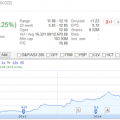Five years ago investors could not get enough of Brazil. Today, many have written off the country following several years of poor performance, decelerating growth and chronically high inflation. If Brazil is to reclaim its place as an investment destination, its equity market will either need to get cheaper, or a more obvious catalyst—preferably a pro-reform agenda—will have to emerge.
A cursory look at a chart of the Brazilian stock market would justify the use of the term ‘rollercoaster ride’. Brazilian equities tumbled 20{01de1f41f0433b1b992b12aafb3b1fe281a5c9ee7cd5232385403e933e277ce6} from the fall of 2013 through last spring, then proceeded to rebound nearly 40{01de1f41f0433b1b992b12aafb3b1fe281a5c9ee7cd5232385403e933e277ce6} on hopes for a more reform-minded government being elected in the presidential election that took place in October. When that proved illusory, the market started to fade again. From last September’s highs to today, Brazilian equities are down more than 20{01de1f41f0433b1b992b12aafb3b1fe281a5c9ee7cd5232385403e933e277ce6} and over 40{01de1f41f0433b1b992b12aafb3b1fe281a5c9ee7cd5232385403e933e277ce6} in U.S. dollar terms. If you look at the longer term, a dollar based investor is basically back to where they were at the start of the bull market in 2009. What accounts for this fall from grace?
Collapse in growth. Arguably the biggest disappointment has been the steady erosion in economic growth. In 2010 Brazil grew by over 7{01de1f41f0433b1b992b12aafb3b1fe281a5c9ee7cd5232385403e933e277ce6}, but since then a drop in commodity prices and a lack of structural reforms have been punishing for the economy. Brazil did not grow at all last year, and is expected to stagnate again in 2015.
Inflation. Despite stalling growth, inflation has remained stubbornly high. Inflation came in at about 6.5{01de1f41f0433b1b992b12aafb3b1fe281a5c9ee7cd5232385403e933e277ce6} last year, which is near the upper-end of the central bank’s target range, and is above 7{01de1f41f0433b1b992b12aafb3b1fe281a5c9ee7cd5232385403e933e277ce6} today.
Debt. Consumers, as well as the government, are borrowing more amid weakened economic conditions. Gross debt for Brazil is now around 64{01de1f41f0433b1b992b12aafb3b1fe281a5c9ee7cd5232385403e933e277ce6} of its gross domestic product. The burden is even more problematic if you consider the country’s high interest rates—the policy rate was just raised to 12.75{01de1f41f0433b1b992b12aafb3b1fe281a5c9ee7cd5232385403e933e277ce6}, one of the highest among major economies—which dramatically increase the costs of servicing debt. The credit rating on national champion oil producer Petrobras was recently lowered to junk status, adding to investor worries that Brazil’s sovereign debt will suffer the same fate.
Corruption. An ongoing bribery investigation centered around Petrobras was yet another pain point. In recent weeks, the scandal has ensnared more politicians with allegations now reaching senior members of Congress. As the Petrobras scandal worsens, both stocks and bonds have sold off, with 10-year rates climbing back up to record levels.
For investors looking to bottom fish, there is some hope. In the long run, Brazil has several things working to its advantage: a young population, a large and growing middle class, stable democracy and abundant natural resources. But in the near term, our outlook is not positive and hasn’t improved since the October election. For one, we don’t think Brazilian stocks are cheap enough to attract value investors. Despite trading roughly at 1.25 times the price-to-book value, the market was a bigger bargain back in late 2013 (in both absolute and relative terms). And without a clear catalyst, a stock rally is unlikely to happen. Last year’s bounce back, while short-lived, was built on the possibility of change. Unless the current Dilma Rousseff administration focuses more on structural reforms and efforts to spur growth, the stock market will probably need to fall further before investors are willing to take another chance on Brazil.
Source: Bloomberg.
Russ Koesterich, CFA, is the Chief Investment Strategist for BlackRock and iShares Chief Global Investment Strategist. He is a regular contributor to The Blog and you can find more of his posts here.
© 2015 BlackRock Asset Management Canada Limited. All rights reserved. iSHARES and BLACKROCK are registered trademarks of BlackRock, Inc., or its subsidiaries in the United States and elsewhere. Used with permission. iSC-1662
SOURCE: BlackRock Blog | Global Market Intelligence – Read entire story here.


